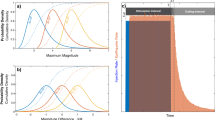Abstract
Induced seismicity in geothermal projects is observed to continue after shut-in of the fluid injection. Recent experiments show that the largest events tend to occur after the termination of injection. We use a probabilistic approach based on Omori’s law and the Gutenberg–Richter magnitude–frequency distribution to demonstrate that the probability of exceeding a certain maximum magnitude still increases after shut-in. This increase is governed by the exponent of Omori’s law q and the Gutenberg–Richter b value. For a reduced b value in the post-injection phase, the probability of occurrence directly after shut-in can be even higher than the corresponding probability for an ongoing injection. For the reference case of q = 2 and a 10% probability at shut-in time t S to exceed a given maximum magnitude, we obtain an increase to 14.6% for t = 2t S at a constant Gutenberg–Richter b value after shut-in. A reduction of the b value by one quarter leads to a probability of 20.5%. If we consider a constant probability level of occurrence for an event larger than a given magnitude at shut-in time, this maximum magnitude increases by 0.12 units for t = 2t S (0.26 units for a reduced b value). For the Soultz-sous-Forêts (France) injection experiment in 2000, recent studies reveal q = 9.5 and a b value reduction by 14%. A magnitude 2.3 event 9 h after shut-in falls in the phase with a probability higher than for the continued injection. The probability of exceeding the magnitude of this post-injection event is determined to 97.1%.



Similar content being viewed by others
References
Aki K (1965) Maximum likelihood estimate of b in the formula log n = a − bm and its confidence limits. Bull Earthq Res Inst 43:237–239
Bachmann CE, Wiemer S, Woessner J, Hainzl S (2011) Statistical analysis of the induced Basel 2006 earthquake sequence: introducing a probability-based monitoring approach for enhanced geothermal systems. Geophys J Int 186(2):793–807. doi:10.1111/j.1365-246X.2011.05068.x
Charléty J, Cuenot N, Dorbath L, Dorbath C, Haessler H, Frogneux M (2007) Large earthquakes during hydraulic stimulations at the geothermal site of Soultz-sous-Forêts. Int J Rock Mech Min Sci 44(8):1091–1105
Cuenot N, Dorbath C, Dorbath L (2008) Analysis of the microseismicity induced by fluid injections at the EGS site of Soultz-sous-Forêts (Alsace, France): implications for the characterization of the geothermal reservoir properties. Pure Appl Geophys 165(5):797–828. doi:10.1007/s00024-008-0335-7
Häring MO, Schanz U, Ladner F, Dyer BC (2008) Characterisation of the Basel 1 enhanced geothermal system. Geothermics 37(5):469–495
Langenbruch C, Shapiro SA (2010) Decay rate of fluid induced seismicity after termination of reservoir stimulations. Geophysics 75(6):Ma53–Ma62. doi:10.1190/1.350600
Langenbruch C, Dinske C, Shapiro SA (2011) Inter event times of fluid induced earthquakes suggest their poisson nature. Geophys Res Lett 38:L21,302. doi:10.1029/2011GL049474
Majer EL, Baria R, Stark M, Oates S, Bommer J, Smith B, Asanuma H (2007) Induced seismicity associated with enhanced geothermal systems. Geothermics 36(3):185–222
Parotidis M, Shapiro SA (2004) A statistical model for the seismicity rate of fluid-injection-induced earthquakes. Geophys Res Lett 31(17):L17,609. doi:10.1029/2004GL020421
Parotidis M, Shapiro SA, Rothert E (2004) Back front of seismicity induced after termination of borehole fluid injection. Geophys Res Lett 31(2):L02,612. doi:10.1029/2003GL018987
Shapiro SA, Dinske C, Kummerow J (2007) Probability of a given-magnitude earthquake induced by a fluid injection. Geophys Res Lett 34:L22,314. doi:10.1029/2007GL031615
Shapiro SA, Dinske C, Langenbruch C, Wenzel F (2010) Seismogenic index and magnitude probability of earthquakes induced during reservoir fluid stimulations. Lead Edge 29(3):304–309. doi:10.1190/1.3353727
Utsu T (1965) A method for determining the value of b in a formula log n = a − bm showing the magnitude–frequency relations for earthquakes. Geophys Bull Hokkaido Univ 13:99–103
Wenzel F, Barth A, Langenbruch C, Shapiro S (2010) Occurrence probability and earthquake size of post shut-in events in geothermal projects. In: Ritter J, Oth A (eds) Proceedings of the workshop induced seismicity, 30, 2010 15–17 November. ECGS Blue Book, Luxembourg
Wessel P, Smith WHF (1998) New, improved version of Generic Mapping Tools released. EOS, Trans AGU 79, 579 pp
Acknowledgement
We thank an anonymous reviewer for helpful and constructive remarks. Figures were made using GMT (Wessel and Smith 1998).
Author information
Authors and Affiliations
Corresponding author
Rights and permissions
About this article
Cite this article
Barth, A., Wenzel, F. & Langenbruch, C. Probability of earthquake occurrence and magnitude estimation in the post shut-in phase of geothermal projects. J Seismol 17, 5–11 (2013). https://doi.org/10.1007/s10950-011-9260-9
Received:
Accepted:
Published:
Issue Date:
DOI: https://doi.org/10.1007/s10950-011-9260-9




